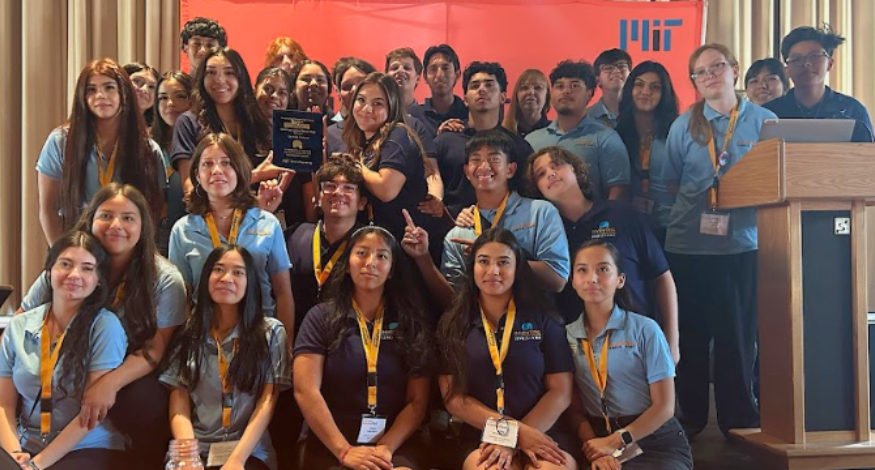Students at Calistoga High School (pictured above) invented tools to help wildland firefighters and agricultural workers–inventions they’re working on patenting. Heather Brooks, a Chemistry and Physics Teacher and Engineering Club Advisor, recently sat down with Chinwe Ohanele Agwu, Senior Program Manager for The Michelson Institute for Intellectual Property, to share her student’s inventions and her work with the Lemelson-MIT program. We hope you are inspired by the students and have an opportunity to participate in the program!
Chinwe: Lemelson-MIT InvenTeams have not only provided a pathway for high school students to understand the value of intellectual property (IP), but also the $7,500 grants have led to inventions that solve real-world problems. How would you describe the impact of the invention program on your students?
Heather: The Lemelson-MIT Invention education program has created long-lasting and effective positive changes for my students at Calistoga High School, their parents, our local community, business, and school overall. Students now understand the power of their education and how to apply all subject matters to the real world through invention, which helps their community.
In the past, the education system has overlooked students and their fullest potentials, both academically and creatively. Invention education has empowered all of our students and united our community. The students see themselves as capable of tackling any job, college, or career they desire because of the experiences they have gained through this program.
Chinwe: Would you please share what your students invented and how they came up with the invention?
Heather: 32 students invented a SMART, wearable cooling device for firefighters working on wildland fires. They also invented a SMART, wearable cooling and heating device for agricultural field workers to wear while working.
The students came up with the inventions because multiple wildland fires nearly burned down our town, Calistoga. The firefighters saved our town, and the students wanted to give back to them. Additionally, the second invention focused on agricultural workers because many of their family members work in agriculture and expressed a need.
Chinwe: Could you share one to two stories about your students?
Heather: We have students on our team who have come from other countries when they were little, learned the language and the culture here, and worked hard at everything they have done in life. If it were not for the invention program, the current education system would have overlooked them. Thankfully, through the Lemelson-MIT InvenTeams program, these students learned and shone with their work ethic, creativity, engineering, technology, and entrepreneurship capabilities and skills.
After inventing and receiving patent-pending on their invention, they want to continue this pathway to become engineers. This program has helped them access their fullest academic potentials, which is what education should do for all students.
We also saw a variety of student talents surface throughout the invention process. Our class and team operate similarly to a company, where each student has a specialty job and talent that they have sculpted and developed throughout the program. To do so, students have teamed with members of the community to learn firsthand how to run and do the different jobs. The newly uncovered talents and drive are fueling the students as they unlock their fullest potential, pursuing careers and college majors!
Chinwe: What are the names of the students on your invention team this year?
Heather: Calistoga High School’s invention team this year included Thalia Alfaro, Carla Alvarado Negrete, Daisy Avina Hernandez, Logan Brooks, Troy Brooks, Cesar Chino, Zeneb Cortez, Bernardo Cruz, Bianca Diaz De Niz, Karina Diaz, Elias Escobar, Graham Grove, Violet Grove, Raul Guerrero Parada, Litzy Hernandez Avina, Arlette, Hernandez-Quevedo, Aaron Heth, Landon Kohler, Cindy Lopez, Xitlali Lopez-Quirino, Jose Montanez, Kelly Montanez, Alexa Navarrete-Avila, Daisy Robles, Ana Rosete, Jimena Rubio Arias, Guadalupe Rubio Pacheco, Jennifer Servin-Flores, Jayden Sibbu, and Beatrix Webb.
Chinwe: You mentioned the community’s needs directly inspired the inventions. Would you like to share more about your program, your student inventors, community, or school?
Heather: Calistoga High School is a title one, a low income school. The invention team is 72% LatinX, 25% white and 3% Filipino. As a whole, the team ise 62% females and 38% males. 22 students, or 68.75%, are redesignated English learners who started with limited English and are now fluent in English. 23 students, or 75%, are fluent in two or more languages ~ 75%.
Chinwe: How can IP champions learn more about your students’ patents and the InvenTeams program?
Heather: We’re excited to showcase their work during a webinar on October 22nd. During the discussion, we will highlight the journey of student inventors and the legal partners who helped protect their ideas. Attendees will hear from students about their experiences in inventing and working with lawyers and to learn from the legal perspective on assisting students with patent registrations. We hope to see you there!
In the meantime, if you’d like to learn more about the Calistoga High School InvenTeam, visit this page.
The Michelson Institute for Intellectual Property, an initiative of the Michelson 20MM Foundation, provides access to empowering IP education for budding inventors and entrepreneurs. Michelson 20MM was founded thanks to the generous support of renowned spinal surgeon Dr. Gary K. Michelson and Alya Michelson. To learn more, visit 20mm.org.
